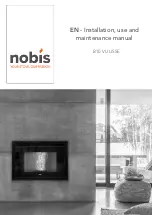
Use and Maintenance Manual model “B10 V ULISSE”
6
ENGLISH
1.8 SPARE PARTS
Please, use only original spare parts.
Do not wait for the components to wear from use
before replacing them.
This measure is intended to prevent accidents
to people, animals or property from occurring in
the event of product malfunctioning caused by
defective spare parts.
We recommend you to contact authorized staff for
the replacement of spare parts, worn parts and to
carry out extraordinary maintenance.
1.9 IDENTIFICATION PLATE
The plate placed on the back of the product
outlines all the characteristic data of the appliance,
including the Manufacturer's data, serial number and
CE marking.
1.10 PRODUCT DISPOSAL
Demolition and disposal of the product is at the
sole responsibility of the user, who should do so in
compliance with legislation in force in his country con-
cerning safety matters, respect and safeguard of the
environment.
At the end of its useful life, the product must not be
disposed of as urban waste.
It can be delivered to specific differentiated waste
collection centres made available by municipal
administrations, or dealers providing this service.
Disposing of the product as differentiated waste
means avoiding any possible negative consequences
for both health and environment deriving from
inadequate disposal. Furthermore, it allows for the
recovery of the materials the product is made with,
so as to obtain important savings in energy and
resources.
1.11 HERMETIC PRODUCT
Products manufactured with a perfectly hermetic
structure do not consume oxygen in the environ-
ment, for they take all the air they need outdoor
(when properly installed). Therefore, they can be
positioned inside all homes with a high level of insu-
lation, such as “passive houses” or with “high ener-
gy efficiency”. Thanks to this technology, there is no
risk of smoke emissions in the environment and no
ventilation grates are necessary.
As a result, no cold air flows - which can make the
environment less comfortable and reduce the
overall efficiency of the system- are created. Hermetic
products can also be installed in the presence of
forced ventilation or in premises which can go into
negative pressure - if compared to the outside.
2
CHARACTERISTICS OF PELLETS
Wood pellets are fuel made from pressed sawdust,
often recovered from carpentry processing waste.
The material used cannot contain any foreign
substances such as glue, varnish or other synthetic
substances.
After being dried and cleaned of impurities, sawdust
it is pressed by means of a matrix: the sawdust heats
due to high pressure, activating the natural binders in
the wood; by doing so, pellets maintain their shape
even without adding artificial substances. The density
of wood pellets vary according to the type of wood
and can be up to 1.5 or twice as much that of natural
wood. Pellet cylinders have a diameter of 6mm and
a variable length of 10 to 40mm.
Their density is equal to approx. 650 kg/m3. Due to
their low water content (< 10%), they have a high
energy content.
The main quality certifications for pellets existing on
the European market make it possible to guarantee
that the fuel falls into class A1 according to ISO 17225-
2: 2014 (ex EN 14961). Examples of these certifications
are ENPlus, DINplus, Ö-Norm M7135. In particular,
such certifications guarantee that the following char
-
acteristics are observed:
• heating power: 4.6 ÷ 5.3 kWh/kg;
• water content: ≤ 10% of weight;
• percentage of ash: max 1.2% of weight
(A1 under 0.7%);
• diameter: 6±1/8±1 mm;
• length: 3÷40 mm;
• content: 100% untreated wood without any
additional binder substances (percentage of bark
max 5%);
• packaging: in sacks made from ecocompatible or
biodegradable material.
For its products, the manufacturer suggests use class
A1 certified fuel complying with EN ISO 17225-2:2014
standard, certified DIN PLUS (more restrictive than class
A1) or else O-NORM M7135.
Pellets must be stored in a dry environment which is
not excessively cold. We also suggest you to keep
some bags of pellets where the product is installed
and operating, so as to dry any humidity in them.
Non-compliance with this aspect reduces the fuel
thermal power. This means that the product will need
greater maintenance.







































